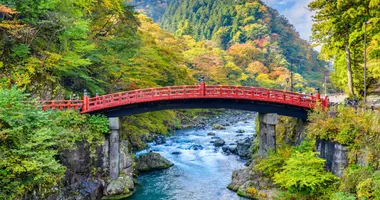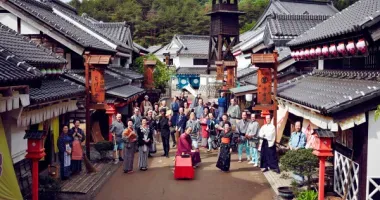Oya Valley Guide
Oya, Utsunomiya, Tochigi Prefecture 大谷宇都宮栃木県
- Oya Stone
- Oya Valley
- Oya-ji Temple and Senju Kannon
- Heiwa Kannon
- Oyakeikan Park
- Oya Shiryokan (Oya Stone Museum)
- Accommodation in Utsunomiya
- Getting To Utsunomiya
- Oya Valley Access
- Japan City Guides
by Johannes Schonherr
Utsunomiya City, about 100 km north of Tokyo, acquired a treasure when it incorporated the town of Oya, located about 7km to the north-west of downtown Utsunomiya.
While Utsunomiya itself, the capital of Tochigi Prefecture, is flat, functional and not exactly famous for outstanding attractions, Oya offers the opposite: an impressive landscape of bizarrely shaped rocks and an assortment of historical sites well worth a day trip all the way from Tokyo.
Utsunomiya Station is a stop on the Tohoku Shinkansen Line as well as on the JR Tohoku Main Line, starting out of Tokyo's Ueno Station.

Vintage quarry landscape in Oya, Utsunomiya, Tochigi Prefecture

Matsugamine Catholic Church, Utsunomiya, Tochigi Prefecture
Once arriving in Utsunomiya, it might be best to buy an Oya 1-Day Ticket at the Kanto Bus Center just outside the West Exit of Utsunomiya Station, to the left of the Chisun Hotel.
That bus ticket will not only cover your fare out to Oya but also the admission fee to two of the main attractions of Oya, Oya-ji Temple and the Oya Stone Museum.
The other attractions in Oya are free of charge. In addition, you can make stops along the way to Oya and visit a few interesting sites in Utsunomiya proper. The Futaraayama Shrine for example, closely intertwined with the history of Utsunomiya, or the Matsugamine Catholic Church, entirely built of Oya Stone.

Typical storage house built of Oya Stone, Oya, Utsunomiya, Tochigi Prefecture

Rocks at the Sugata River, Oyakeikan Park, Oya, Utsunomiya, Tochigi Prefecture
Oya Stone
Oya Stone is a volcanic stone that can only be found in Oya. The stone is not only praised for its versatility as a building material, its warm texture and the variety of its color but also for being perfectly fire-proof and heat-absorbing.
The latter qualities have made it a favored material in building storage houses across the northern Kanto region.
Oya Stone became famous, sort of, when Frank Lloyd Wright used it as finish for his design of the Tokyo Imperial Hotel (opened in 1923, demolished in 1967, though the hotel lobby has been preserved at Meiji Mura in Aichi Prefecture).
Riding the bus towards Oya, heading out of the densely built-up downtown area of Utsunomiya with its concrete towers, you will soon notice an increasing frequency of residences and storage buildings of vintage design constructed of more or less weather-beaten stone. Their colors range from greyish white to greyish brown. These structures are made of Oya Stone.
Oya Valley
Eventually the bus turns into the Oya Valley. Oya Valley is not the official name for the area but since Oya translates as Big Valley and all the attractions of Oya are located within the Sugata River Valley, it should serve here as a descriptive term for the area.
In any case, once the bus turns into the valley, you enter bizarre rock country. It's sometimes hard to say what exactly shaped the rocks - natural erosion taking place over millions of years or human interference in the form of intensive quarrying in recent centuries. Either way, the outcome is bizarre.
Strange rock formations line the road while below them, on street level, Oya Stone buildings dominate the rural townscape.

Oya-ji Temple, Oya, Utsunomiya, Tochigi Prefecture

Senju Kannon, Oya-ji Temple. Photo of a photo as it is prohibited to take pictures of the original Kannon
Oya-ji Temple and Senju Kannon
Get off the bus at the Oya-ji stop. That's the stop for Oya-ji Temple. The temple has been built right into an interestingly shaped rock front and it houses the oldest known stone carving of Goddess Kannon in Japan, the Senju Kannon. In Buddhism, Kannon is the Goddess of Mercy.
The Senju Kannon, the holiest site of the temple, is almost four meters high and it features the goddess as having "a thousand" arms, holding an eye in each hand, "representing the desire to save mankind".
Oya-ji Temple is said to have been founded by Buddhist scholar Kobo Daishi in 810 AD.
As so often, there is a legend associated with the origins of the temple.
In ancient times, a well of clear fresh water was sprouting forth from a hidden dent in the rock front. However, in the well lived a venomous serpent and from time to time, the serpent would spit its poison into the water, killing people who merely touched the water.
When Kobo Daishi passed through the area, the villagers told him about their troubles with the snake. Kobe Daishi went into the hidden dent and when he emerged again (here the accounts differ, some say after one night, others after ten days), he told the villagers that he had taken care of the snake. Kobo said sayonara and went on his way. When the villagers themselves entered the dent, they were greeted by the shining carving of the Senju Kannon.
The serpent had been transformed into a white snake, embodying a benevolent old Indian god. To this day, in a small red tower in the temple's Japanese garden, a living white snake is kept.

Japanese garden at Oya-ji Temple. A holy white snake is held in the red tower on the right
Inspired by Kobo Daishi, the villagers became devout Buddhists and erected the temple surrounding the Senju Kannon.
More recent research came up with very different but no less remarkable assumptions about the origins of the Senju Kannon. Comparative studies claim close similarities between the Senju Kannon and ancient stone carvings in Bamiyan Valley, Afghanistan. An unknown Buddhist stone carver from Afghanistan might have made his way to Heian Period Japan (794-1185) and created the Senju Kannon, the researchers concluded.
Besides the Kannon carving, the temple also houses a number of Buddha carvings from the same period of the Senju Kannon.
In 1965, Japanese archaeologists extensively surveyed the temple area and excavated in its vicinity a large number of artifacts from the pre-historic Jomon and Yayoi periods. Those artifacts, including an actual skeleton, are on display in a small museum attached to the temple.
It is prohibited to photograph the actual Senju Kannon but picture material including postcards of the Kannon is readily available at the temple.

Heiwa Kannon statue, Oya, Utsunomiya, Tochigi Prefecture
Heiwa Kannon
It's a short walk from the temple to the Heiwa (Peace) Kannon statue, carved from 1948 to 1956 into an old quarry as a symbol of peace and a memorial to those who had died in World War II. Standing at 27m tall, it grandly overlooks the surrounding rock landscape.

Vintage quarries shape the Oya landscape. Oya, Utsunomiya, Tochigi Prefecture
Oyakeikan Park
Oyakeikan Park (Oya Experience Park), about a five minute walk from Oya-ji Temple, offers good views onto the Oya rocks along the Sugata River. For drivers, the park offers free parking and barbecue facilities and it makes a good starting point for exploring the adjacent areas with their strangely shaped stone and quarry surroundings.

Oya Shiryokan Underground Hall, Oya, Utsunomiya, Tochigi Prefecture
Oya Shiryokan
A further short walk will take you to the Oya Shiryokan Museum, translated variously as the Oya History Museum or the Oya Stone Museum.
The museum consists of two sections: a small exhibition on the techniques of vintage quarrying - and a huge underground quarry.
Early in the 20th century, Oya stone quarrying went underground. There, the stone resources were even bigger than on the surface. The move underground meant also that the rock formations above ground could be preserved while a large quantity of stone could be produced at the same time.
Entering the underground quarry hall, you walk down 60m on an iron staircase to reach the ground of the quarry hall. The hall itself is about 30 meters high. Temperatures are refreshing down there with about 13° Celsius throughout the year.
During World War II, Nakajima Zero fighter airplanes were constructed in that underground hall, safe from American bombing attacks.
The hall, at some sections opening up to sun rays from above-ground, is incredibly large and you can spend a long time exploring it. Some sections feature vintage mining tools, others display more recent art installations.
Speaking of art in this context, the hall has been featured in many movies, a poster display at the entrance gives a few examples. Because of its good acoustics, the hall is also occasionally used as a concert venue. Even weddings take place down there as a photo display at the entrance shows, along with contact info for the wedding agency.

Oya Shiryokan Underground Hall, Oya, Utsunomiya, Tochigi Prefecture

Oya Shiryokan Underground Hall, Oya, Utsunomiya, Tochigi Prefecture
Accommodation in Utsunomiya
Much of the hotel accommodation in Utsunomiya is clustered around Utsunomiya Station. Recommended places to stay in Utsunomiya include the Richmond Hotel Utsunomiya-ekimae, Richmond Hotel Utsunomiya-ekimae Annex, Hotel Mystays Utsunomiya, Chisun Hotel Utsunomiya and Hotel Sunshine Utsunomiya. See here for a full listing of over 20 hotels in Utsunomiya.
Access - Getting to Utsunomiya
Take the Tohoku Shinkansen from Tokyo Station to Utsunomiya Station (50 minutes) or the "Rabbit" rapid train of the JR Utsunomiya Line / Tohoku Main Line starting out of Tokyo Ueno Station (1 hour 25 minutes).
Various city brochures and maps in English and Japanese are available at Utsunomiya Tourist Information at Utsunomiya Station.
Utsunomiya City Tourist Information PDF in English
Access to Oya
Oya 1-Day Bus Ticket
The best way to visit Oya is by buying an Oya 1-Day Ticket at the Kanto Bus Center outside the West Exit of Utsunomiya Station, just to the left of the Chisun Hotel.
The ticket costs 1600 yen for adults (older than 16), 1100 yen for children age 12 - 15, 500 yen for children age 6 - 11.
The ticket covers not only the bus rides but also the admission for Oya-ji Temple and the Oya Shiryokan.
You can get off the bus on the way to visit further attractions.
At the bus center, an English-language flyer is available which explains in detail which bus to take and how to use the ticket.
Bus
The bus to Oya from Utsunomiya Station is bus number 45, bound for Oya Tateiwa. It leaves at bus stop number 6 outside the West Exit of Utsunomiya Station and takes about 40 minutes to reach Oya.
Oya-ji Temple
Opening times
April to September: daily from 8.30am to 5pm, September to March: 9am to 4.30pm
Closed from December 19th to December 31st.
Address
Tochigi Prefecture, Utsunomiya City, Oya Town 1198
Tel: 028 652 0128
Oya Shiryokan
Open daily from 9 am to 5 pm, closed from December 28th to December 31st.
Admission: adults 800 yen, children 400 yen (admission is covered if you go with the Oya 1-Day Bus Ticket)
Address: Tochigi Prefecture, Utsunomiya City, Oya Town 909
Tel: 028 652 1232
Website: www.oya909.co.jp (in Japanese)
Wedding in the Oya Shiryokan Underground Hall: contact J's acul Wedding by phone at 028 651 3254 or see the agency's Japanese-language website: www.kekkon-jpn.com/chapel.php?cm_id=47
Oya on google maps

Wedding at the Oya Shiryokan Underground Hall, Oya, Utsunomiya, Tochigi Prefecture
Japan Auction Service
Books on Japan
Oya Valley outside Utsunomiya offers an impressive landscape of bizarrely shaped rocks and an assortment of historical sites well worth a day trip all the way from Tokyo.
















